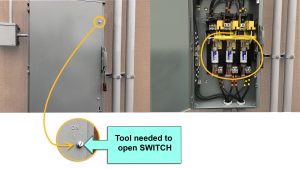How has NEC 2023 changed accessibility rules for circuit breakers and switches?
Overview
Circuit breakers and switches are required to be located in a readily accessible location. Some locations can raise question to whether or not a particular location is accessible. Previous editions of the Code have permitted industrial control panels, and similar locations to contain ove r-current devices. Question has arisen for Type 4X rated enclosures, which are not similar to industrial control panels. The 2023 NEC has changed the wording in 240.24(A) to address these locations. Furthermore, previous editions of the Code have prohibited over-current devices from being located in bathrooms. When a bathroom is occupied, it becomes impossible for maintenance personnel to reset a tripped breaker, or replace a blown fuse. But what about showering facilities and/or locker rooms that pose a similar problem? When the space is occupied, maintenance personnel are unable to get to the overcurrent devices. The 2023 NEC has updated the wording in 240.24(E) to address these additional locations.
r-current devices. Question has arisen for Type 4X rated enclosures, which are not similar to industrial control panels. The 2023 NEC has changed the wording in 240.24(A) to address these locations. Furthermore, previous editions of the Code have prohibited over-current devices from being located in bathrooms. When a bathroom is occupied, it becomes impossible for maintenance personnel to reset a tripped breaker, or replace a blown fuse. But what about showering facilities and/or locker rooms that pose a similar problem? When the space is occupied, maintenance personnel are unable to get to the overcurrent devices. The 2023 NEC has updated the wording in 240.24(E) to address these additional locations.
Applying the 2023 Code
When an overcurrent device trips, it is critical that maintenance personnel are able to quickly mitigate the situation, and restore electrical power. In an effort to ensure that these devices are able to be quickly accessed, the 2023 NEC has updated Subsection 240.24(A), and Subsection 240.24(E). The exception to Subsection 240.24(A) now clarifies that enclosures designed for hazardous locations are also permitted to require a tool to access the overcurrent protection. Additionally, Subsection 240.24(E) now clarifies that in addition to overcurrent protective devices being prohibited from installation in bathrooms, they may also not be located in showering facilities, or locker rooms with showering facilities.
What’s New for the 2023 NEC?
2020 NEC
In the 2020 NEC Section 240.24(A) and (E) read as follows (excluding the unrelated subsections):
(A) Accessibility.
Circuit breakers and switches containing fuses shall be readily accessible and installed so that the center of the grip of the operating handle of the switch or circuit breaker, when in its highest position, is not more than 2.0 m (6 ft 7 in.) above the floor or working platform, unless one of the following applies:
(1) For busways, as provided in 368.17(C).
(2) For supplementary overcurrent protection, as described in 240.10.
(3) For overcurrent devices, as described in 225.40 and 230.92.
(4) For overcurrent devices adjacent to utilization equipment that they supply, access shall be permitted to be by portable means.
Exception: The use of a tool shall be permitted to access overcurrent devices located within listed industrial control panels or similar enclosures.
(E) Not Located in Bathrooms.
In dwelling units, dormitory units, and guest rooms or guest suites, overcurrent devices, other than supplementary overcurrent protection, shall not be located in bathrooms.
2023 NEC
In the 2023 NEC Section 240.24(A) and (E) now read as follows11 now reads as follows:
(A) Accessibility.
Circuit breakers and switches containing fuses shall be readily accessible and installed so that the center of the grip of the operating handle of the switch or circuit breaker, when in its highest position, is not more than 2.0 m (6 ft 7 in.) above the floor or working platform, unless one of the following applies:
(1) For busways, as provided in 368.17(C).
(2) For supplementary overcurrent protection, as described in 240.10.
(3) For overcurrent protective devices, as described in 225.40 and 230.92.
(4) For overcurrent protective devices adjacent to utilization equipment that they supply, access shall be permitted to be by portable means.
Exception: The use of a tool shall be permitted to access overcurrent protective devices located within listed industrial control panels, within enclosures designed for hazardous (classified) locations or enclosures to protect against environmental conditions. An enclosure within the scope of this exception, and all overcurrent protective device(s) within such enclosures as judged with the enclosure open, shall comply with the accessibility provisions of 240.24(A).
(E) Not Located in Bathrooms.
Overcurrent protective devices, other than supplementary overcurrent protection, shall not be located in bathrooms, showering facilities, or locker rooms with showering facilities.
